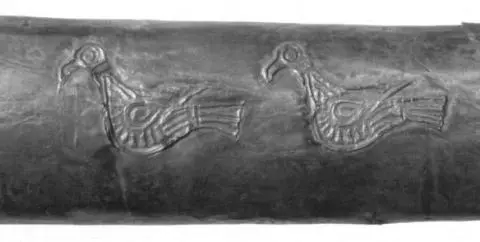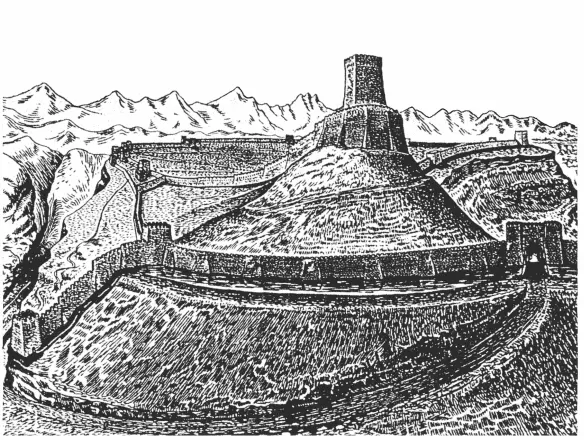As the Pechenegs moved westward they clashed with the Magyars who were, in turn, obliged to leave ‘Levedia’ (probably on the Don River) and migrate to Etelköz (Atelkuz), a territory between the Dneiper river and the Carpathian mountains. The Pechenegs also allied with the Balkan (as distinct from Volga) Bulgarian Tsar Simeon, who invaded Atelkuz in 895, slaughtering any Magyars he could find.
Thus, by the mid-10th century, the western steppes were occupied by nomadic Pechenegs who were nominally subject to the Khazar Khaganate. In reality, however, this Pecheneg migration had not only disrupted northern Khazaria, but also several Greek-speaking coastal settlements on the northern Black Sea (including the city of Phanagoria on the Taman pensinsula), several of which were abandoned. Furthermore, Pechenegs reportedly destroyed Bulgarian-Khazar settlements on the Crimean steppe. Ultimately the Pechenegs were among the main beneficiaries of the final collapse of the Khazar Khaganate, with domination of the steppes west of the River Volga passing to them after the 960s.
Character, strengths and organization
The main part of the Khazar army is thought to have consisted of lightly armed cavalry, though a different picture is provided by archaeological finds and images of elite Khazar warriors. Nevertheless, this assessment may have been substantially true until the beginning of the 8th century, after which heavily armed soldiers who could fight both on horseback and on foot became increasingly important. Such troops also defended the walls of fortresses where, it seems, they came to play a dominant role. Whatever the number and proportion of heavy armoured cavalry in the Khazar army, it was they who normally decided the outcome of a battle, as the primary offensive arm tasked with breaking apart enemy formations. It is equally clear that the full arms and armour of such Khazar armoured shock cavalry must have been very expensive. It is unknown how men acquired such equipment at a time when full armour and top-quality weapons were proportionately much costlier, and rarer, than they would become in the later medieval period.


A Khazer-period sabre and its scabbard from the Caucasus, 10th century, and a close-up of a decorative element from just above the latter’s deep chape. (Furusiyah Art Foundation, inv. RB-136)
While that question remains unanswered, written sources do shed light on the numbers and organization of the Khazar forces. They indicate that during the first phase, from the 7th to the mid-8th century, the army was entirely mounted, and consisted of two elements. The first was drawn from the Tarkhans or tribal nobility of Khazar tribes, many if not most of whom had either lamellar or mail armour or both. The second part of the Khazar army consisted of lightly armed ordinary Khazar tribesmen. All were under the direct command of the Khagan or his Shad or deputy◦– often one of his sons or nephews. Individual units were commanded by experienced and renowned Tarkhans.


Reconstructions of the Khazar-period fortress at Khoumara Karachay in the Cherkess Republic, Russia, and of its gate defences half way up the slope. (Archive of M Zhirohov)
Tarkhans also formed a bodyguard for the ruler, and this could be formidable even though its numbers were not particularly large. In 630, for example, a 3,000-strong detachment under Chorpan Tarkhan was credited with defeating the 10,000-strong Sassanian Persian corps of Goghann. Writing in the early 10th century, the Arab historian Ahmad ibn Atham al-Kufi reported that there were 1,000 Khazar Tarkhans in Derbent in 708, while in 737 the Khazar commander fought with only 4,000 ‘children of the Tarkhans’ against the supposedly 120,000-strong largely Arab army of Marwan ibn Muhammad. (Arab sources are unfortunately very unreliable when giving numbers of troops, e.g. in their claim that the Muslims were defeated by Khazar armies numbering 200,000 or 300,000.)
Following a coup at the end of the 8th century, the Khagan himself was removed from practical responsibility for state administration. This was taken over by a senior figure called the Bek or Beg, who already commanded the army. Nevertheless, the Khagan’s military deputy remained the Shad, but quite who held this title during the 9th and 10th centuries is unclear. The core of the army remained the cavalry elite of Tarkhans. According to the 10th-century Persian scholar Abu Ishaq Ibrahim al-Istakhri, this still numbered 12,000, though later sources reduce this figure to 10,000. But, again according to al-Istakhri, the Khazar Khaganate had no standing army (unlike the main Islamic states of this period), and troops were only summoned to muster when needed.
The ‘feudal’ core, mercenaries and vassals
Arab historians describing a perhaps late version of the Khazar army indicate that it now included full-time professionals who were regularly paid, and thus it may have consisted largely of mercenaries. The situation was eventually clarified by Ibn Ahmad ibn Rustah, a 10th-century Iranian traveller and geographer, who wrote that the ruler’s deputy or Isha (the Shad) obliged prominent people to supply cavalrymen according to the size of their own territories or property. Furthermore, the Shad was now accompanied by, or could muster, 10,000 fully equipped horsemen with flags, spears and strong armour, maintained at his expense and recruited from among the wealthy elite. This sounds remarkably like an early version of medieval Europe’s feudal military system. In practice the core of the Khazar army probably consisted of the personal retinues of the Bek and Shad, plus detachments of wealthy Tarkhans each accompanied by some followers and servants. In addition to this well-equipped elite there would be much larger numbers of tribal warriors, numbering up to 30,000 or 40,000; more rarely, larger numbers may have been raised from the settled peasantry and vassal peoples.
By the middle of the 10th century the Khaganate had shrunk, and many of the strictly Khazar population probably lived in and around the mercantile city of Atil, being no longer nomadic but engaged in agriculture and trade. It is also possible that most military duties had now been transferred to subject peoples and mercenaries. Written sources hint that the later Khagans’ armies largely consisted of non-Khazars, and it is difficult to associate many later warrior burials with identifiable Khazars.
These sources often suggest that Alans played the major role in protecting the Khaganate’s frontiers, but this was not entirely true. While Alan tribes were forcibly resettled in border areas facing Slav tribes, some northern Slavs like the Vyatichi and Radmichi also found themselves under Khazar domination until the end of the Khaganate. As such they did not pose a serious threat, and small frontier fortifications served merely as places of refuge in times of danger. It was only the rise of the Rus in the middle of the 9th century that posed a real threat, causing the Khazars to build a series of true frontier fortresses, but whether any of these were permanently garrisoned also remains unknown.
Читать дальше
















